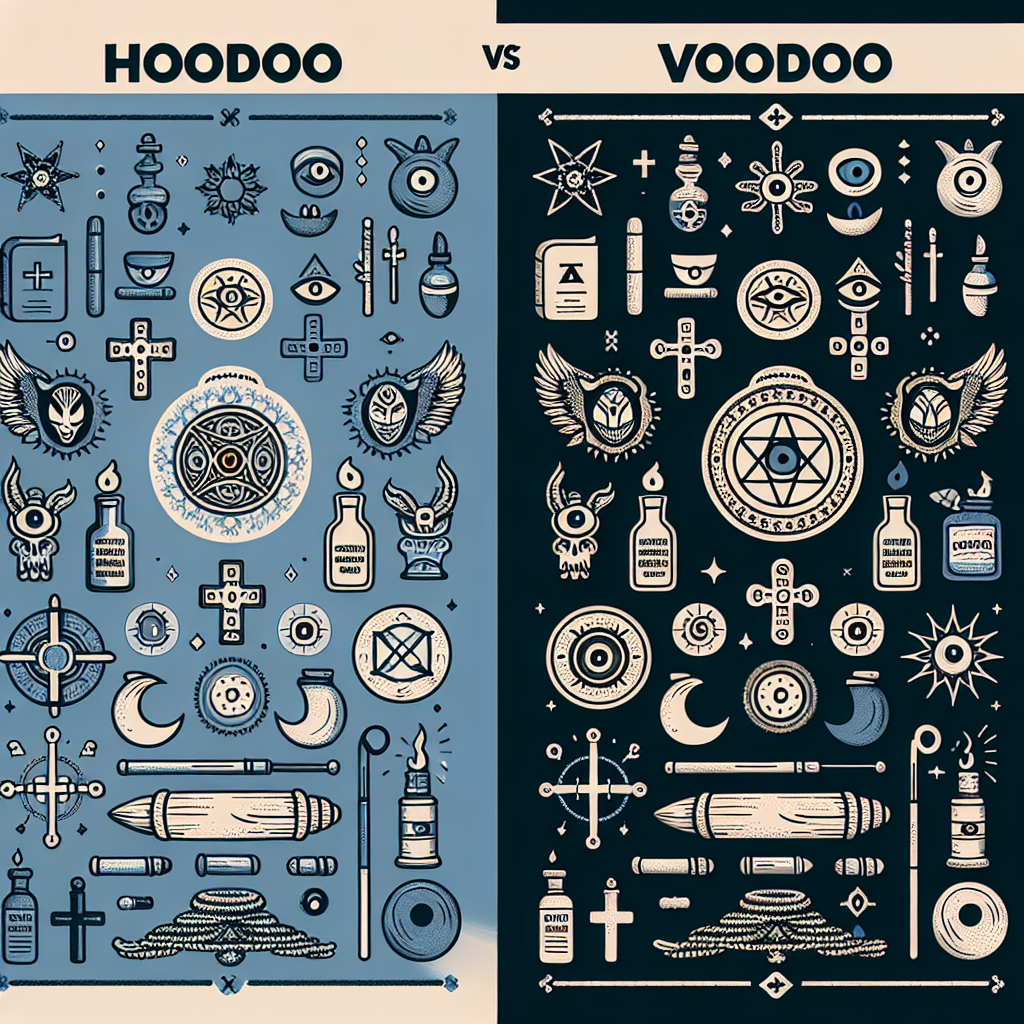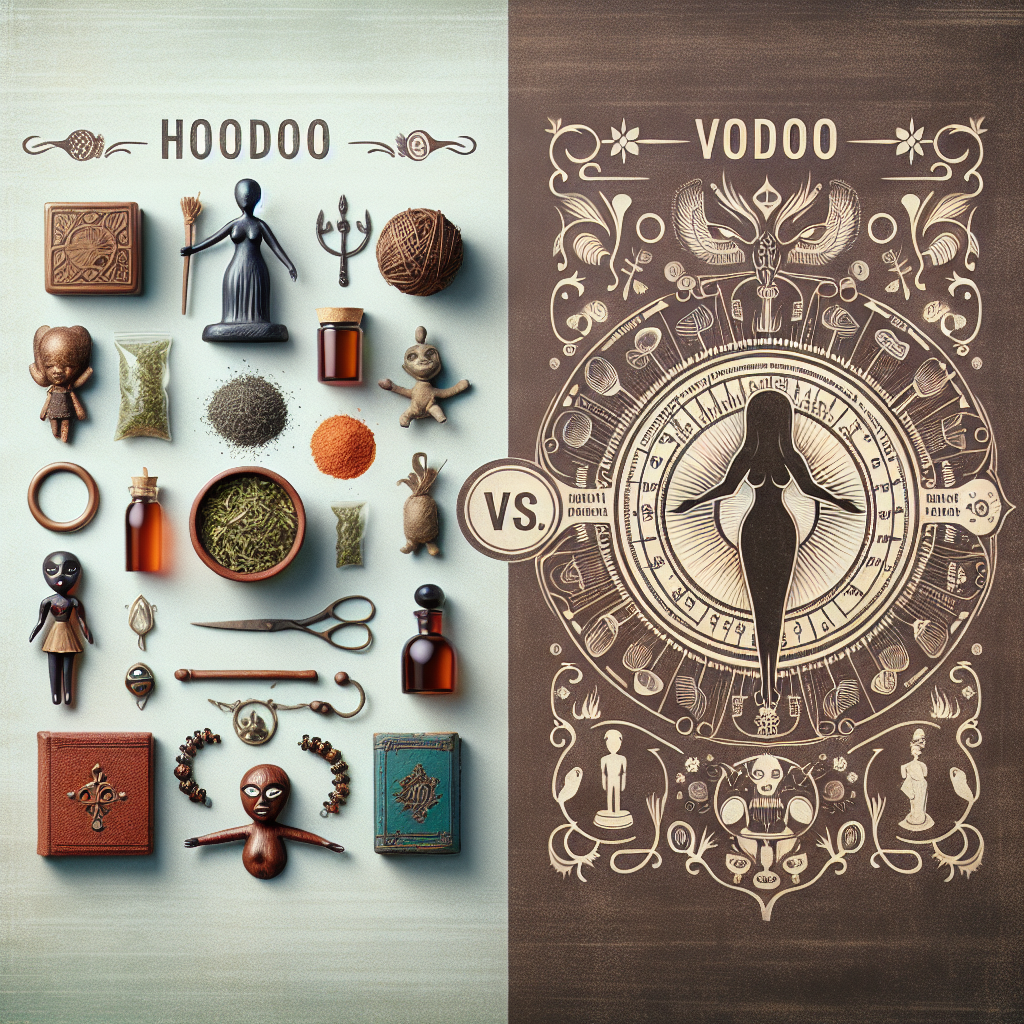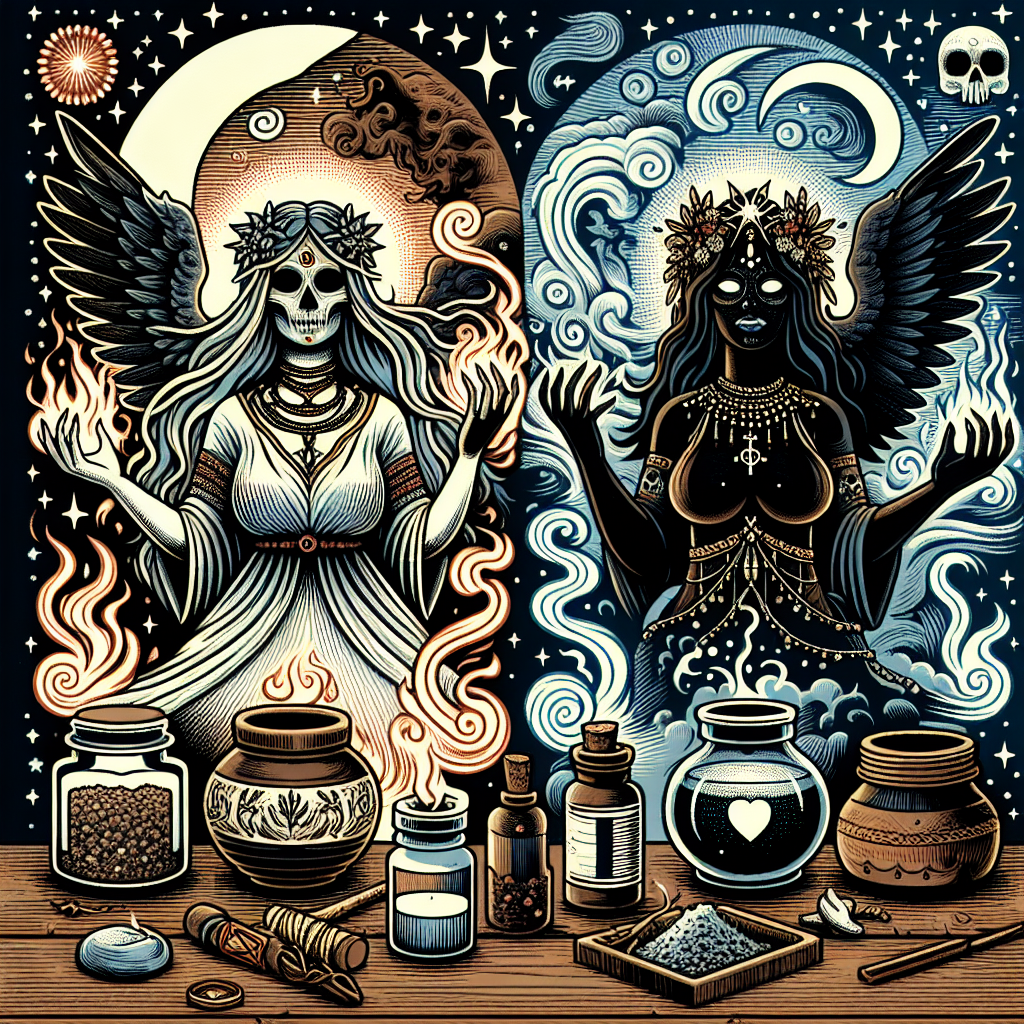As an Amazon Associate I earn from qualifying purchases.

Hoodoo and Voodoo: Complex Traditions Often Confused
Hoodoo and Voodoo are spiritual practices rooted in African traditions, but they have evolved distinctly. Hoodoo, often referred to as “conjure,” is primarily a set of folk magic practices and beliefs without a structured religion. Voodoo, on the other hand, is a syncretic religion fusing African, Catholic, and Native American traditions, particularly prominent in Haiti and Louisiana.
Understanding the differences between these two practices is crucial in today's context where they are often conflated. A Pew Research Center study found that 30% of Americans believe Hoodoo and Voodoo to be identical, highlighting a widespread misunderstanding.
Origins and Cultural Contexts
Hoodoo has its roots in African American communities, especially in the Southern United States. It developed from a mix of African, Native American, and European influences and does not adhere to a formal religious structure. Hoodoo is deeply embedded in African American history and culture, focusing on personal power and survival.
Voodoo originated in the West African Vodun tradition and evolved significantly in Haiti and Louisiana. It is a formal religion with priests, rituals, and a pantheon of deities and spirits. Voodoo ceremonies involve song, dance, drumming, and the invocation of spirits and ancestors.
Spiritual Beliefs and Practices
Hoodoo practitioners primarily believe in using spiritual methods to influence everyday life, such as through spells, charms, and the use of roots and herbs. It is predominantly a practical, results-oriented practice tailored to personal needs and lacks formal initiation.
Voodoo involves a structured hierarchy of deities (Loa) and ancestors who interact with the living through possessions, offerings, and rituals. It requires initiation rites and the guidance of a Houngan (priest) or Mambo (priestess). Voodoo ceremonies aim to establish a connection with the spirit world for communal guidance and support.
Community and Individual Focus
Hoodoo is an individualistic practice often carried out on a personal, private level. It is usually conducted within the confines of one's home, utilizing personal altars and ritual objects. Solutions are tailored to personal issues like love, wealth, and health.
Voodoo is inherently communal, involving elaborate public ceremonies and festivals where entire communities participate. Its practices foster communal bonds and ensure spiritual wellbeing for the community as a whole. The sense of community in Voodoo is echoed in grand events like the annual Fête Gede in Haiti.
Misconceptions and Media Portrayal
Hoodoo is frequently misrepresented as “black magic” in media, often depicted as malevolent and sinister. Movies and TV shows contribute to misconceptions, portraying it as occult and fearsome. This has led to widespread confusion and stigmatization of genuine Hoodoo practices.
Voodoo suffers from similar sensationalism and is often portrayed as mystical and dangerous, focusing on elements like “voodoo dolls” and zombie folklore. While such elements exist, they are far from the whole picture of Voodoo, which is a multifaceted and deeply spiritual religion.
Hoodoo vs Voodoo presents a fascinating look at the distinct yet often confused spiritual practices found primarily within African American and Afro-Caribbean communities. When examining Hoodoo and Voodoo, it's crucial to identify the specific elements that set these two systems apart. Both are rich in culture, history, and deeply rooted spiritual beliefs, but they hold unique characteristics and functions. Here are 20 significant differences between Hoodoo and Voodoo.
1. **Origins and Development:** Hoodoo is primarily an African American folk magic tradition that developed in the Southern United States, influenced by Christian and African beliefs. Voodoo, or Vodou, originates from the African spiritual traditions brought to Haiti by enslaved Africans, merging with indigenous Taino and European Catholic elements.
2. **Religious Integration:** Voodoo is a formal religion with a hierarchy and sacred rites that create a structured belief system centered on the worship of deities (Lwa). Hoodoo, in contrast, is not a religion but rather a form of folk magic rooted in African traditions and integrating elements of Christianity and indigenous practices.
3. **Deities vs Spiritual Entities:** In Voodoo, practitioners honor and serve specific deities known as Lwa, or spirits, who intervene in human affairs. Hoodoo does not focus on deity worship but instead calls upon ancestral spirits, nature spirits, and utilizes the power believed to reside in natural objects.
4. **Use of Rituals:** Voodoo rituals are elaborate and involve community ceremonies, drumming, dancing, and offerings to the Lwa. Hoodoo rituals are typically simpler, more personal, and often involve prayer, candle burning, and the use of gris-gris (charm bags).
5. **Practitioner Roles:** In Voodoo, dividing the religion are Houngans (male priests) and Mambos (female priestesses) formally trained to lead rituals and provide spiritual services. Hoodoo practitioners, often called rootworkers or conjurers, typically practice individually without formal titles or extensive training.
6. **Spiritual Goals:** Hoodoo primarily aims at practical outcomes like love, money, health, and protection through the use of spells and charms. Voodoo, while also addressing practical needs, equally focuses on spiritual growth, divine connection, and community well-being.
7. **Magical Materials:** Hoodoo employs a wide array of materials like herbs, roots, minerals, and animal parts in spellwork, a practice deeply in folk magic. Voodoo also uses these materials but places significant emphasis on symbolic items and ritual objects specific to the Lwa, like dolls, veves (sacred drawings), and specific offerings.
8. **Influence of Christianity:** Christian elements in Hoodoo are profound, with biblical psalms and figures like Moses and Jesus appearing in many conjurations. Voodoo incorporates Catholic saints who are often identified with Voodoo spirits, reflecting the syncretism of African and Catholic traditions.
9. **Community vs Individual Practice:** Voodoo thrives within a community structure, fostering collective rituals and social cohesion. Hoodoo, however, is generally practiced solo, emphasizing personal empowerment and individual problem-solving.
10. **Ceremonial Language:** Voodoo ceremonies employ languages like Haitian Creole, French, and African languages depending on the Lwa being served. Hoodoo practices primarily use English, particularly African American Vernacular English (AAVE), reflecting its development in the United States.
11. **Symbolism and Art:** Voodoo is rich in symbolic art, including Veve symbols traced on the ground to invoke spirits. Hoodoo symbols are less formalized but may include representations of crosses, candles, and other simple symbols mainly derived from Christian iconography.
12. **Ritual Music:** Voodoo rituals heavily incorporate drumming, chanting, and dancing as means to invoke the Lwa and enter spiritual trances. Hoodoo rituals might involve singing hymns or spirituals, but such musical elements are generally less prominent.
13. **Role of Ancestors:** Both Hoodoo and Voodoo venerate ancestors, but in Voodoo, ancestor worship is a central component of religious practice and rituals. Hoodoo also respects ancestors, often seeking their guidance and intervention, but does so in a less formalized manner.
14. **Geographical Spread:** While Voodoo is prominently practiced in Haiti and among Haitian diaspora communities, Hoodoo’s primary region of practice remains the American South, reflecting its development through African American culture.
15. **Healing Practices:** Voodoo employs elaborate healing rituals invoking the Lwa and using herbs, baths, and sacred objects. Hoodoo also focuses on healing but typically through herbal remedies and rootwork directly tied to folk medicine traditions.
16. **Syncretic Celebrations:** Voodoo includes syncretic celebrations that blend Catholic feast days with Voodoo spirit ceremonies. Hoodoo doesn’t typically celebrate syncretic festivals but may observe Christian holidays like Easter and Christmas.
17. **Divination Methods:** Voodoo divination often involves specific techniques such as reading the patterns of cowrie shells or bones, guided by the Lwa. Hoodoo divination practices include card reading, scrying, and other methods influenced by a variety of folk magic traditions.
18. **Protective Measures:** Hoodoo employs protective measures like mojo bags, talismans, and floor washes to guard against evil influences. Voodoo also uses protective charms and rituals but often integrates specific prayers and offerings to Lwa associated with protection.
19. **Magic vs Religion Debate:** Hoodoo focuses on folk magic without a structured religious system, grounded in achieving tangible results. Voodoo blends magic within its religious context, making magical practices a part of a broader spiritual and religious experience.
20. **Cultural Perception:** Hoodoo is often viewed as secretive and purely practical in nature, primarily concerned with individual problems and remedies. Voodoo is often misunderstood and sensationalized, portrayed with a mysterious allure, yet is deeply communal and spiritual in essence.
In the United States alone, an estimated 60 million people believe in some form of folk magic practices like those found in Hoodoo and Voodoo.
Spiritual Foundations
One of my first personal encounters with Hoodoo illuminated its strong Christian foundations. Growing up in the American South, I often saw neighbors using Psalms and Biblical verses as part of their Hoodoo practices. It was common to see altars featuring the Bible, along with candles and roots, emphasizing the importance of Christian spirituality in Hoodoo work.
In contrast, my exposure to Voodoo came through conversations with a friend whose family practiced Haitian Vodou. They explained how Voodoo is deeply rooted in African spirituality interwoven with elements of Catholicism. The Lwa, or spirits, are venerated forms that correspond to Catholic saints, illustrating a much more integrated blend of African and Catholic religious practices compared to Hoodoo's predominantly Christian influence.
The experience showed me how different the spiritual bases of each tradition are. Hoodoo felt more like a folk practice integrated within a Christian framework, whereas Voodoo presented itself as a more intricate religion with a pantheon of spirits and rituals that require dedicated practice and understanding. My personal experiences with both practices have allowed me to appreciate these differences in spiritual foundations profoundly.
Ritual Practices
My first hands-on experience with a Hoodoo ritual involved a simple protection spell. I was instructed to gather specific herbs, roots, and a white candle, all elements that were easily accessible. The ritual involved reciting a Psalm while lighting the candle and sprinkling the herbs around my home. It was straightforward and reflected Hoodoo's practical, results-oriented nature.
When I observed a Voodoo ceremony, the complexity was immediately evident. The gathering included elaborate drumming, dancing, and invoking various Lwa to possess practitioners who would then relay divine messages. The rituals often take hours and involve an entire community, showing the collective and multifaceted nature of Voodoo practices. The experience was intense and deeply spiritual, unlike anything I'd encountered in Hoodoo.
This ritual complexity in Voodoo contrasted sharply with the more individualistic Hoodoo practices I had learned about. Hoodoo's rituals can often be done alone and are aimed at immediate, practical needs. Observing Voodoo, on the other hand, demonstrated the importance of community participation and specialized knowledge in conducting ceremonies, highlighting another significant difference between the two.
Material Components
Living in a region where Hoodoo is practiced, I found it fascinating that many of the necessary materials could be sourced locally. Everyday items like red brick dust, nails, and various roots can easily be found in local stores and markets. This accessibility made it easier to try out various Hoodoo practices, reinforcing its practical, folk-magic roots.
In contrast, the material components used in Voodoo were often exotic and intricate. During a visit to a Voodoo practitioner, I was introduced to various items like specially prepared Vodou dolls, intricate veves (sacred symbols), and ritual objects that had to be consecrated by a Voodoo priest or priestess. These items weren't just tools; they were sacred objects imbued with spiritual significance.
Through these experiences, I realized how differently each practice treats its material components. Hoodoo's materials are largely utilitarian and accessible, aligning with its practical nature. Voodoo's materials, on the other hand, carry a deeper sacred significance, often requiring proper consecration and specific preparation, reflecting the complex spirituality of the practice.
Cultural Roots
My interactions with Hoodoo practitioners often led to discussions about its deep roots in African-American culture and history. Through storytelling and shared experiences, I learned how Hoodoo has been a means of survival and empowerment for African-American communities. The cultural expressions within Hoodoo, such as the songs, prayers, and remedies, are deeply embedded in the African-American experience, especially in the Southern United States.
Voodoo, as I encountered it through my Haitian friend, revealed its rich tapestry of African, Native American, and European influences. The stories they shared about the Haitian Revolution and the role of Voodoo in unifying and empowering enslaved people were incredibly powerful. It became clear how Voodoo is not just a spiritual practice but a significant cultural force in Haiti and among the Haitian diaspora.
These cultural insights into both practices highlighted another key difference. Hoodoo serves as a folk practice intertwined with African-American history and Christian elements, while Voodoo is a full-fledged religion with a more global set of influences. Understanding these cultural roots gave me a deeper appreciation for the distinct identities that each practice holds within their respective communities.
1. What is the main difference between Hoodoo and Voodoo?
The main difference between Hoodoo and Voodoo is that Hoodoo is a form of folk magic and spirituality primarily influenced by African, Native American, and European traditions, practiced mainly in the southern United States. Voodoo, on the other hand, is a religion with West African roots, particularly associated with Haiti and Louisiana, involving elaborate rituals, deities (lwa), and ancestor worship.
2. Is Hoodoo a religion?
No, Hoodoo is not a religion. It is a tradition of African American folk magic that incorporates elements of various spiritual beliefs and practices but does not involve worship of deities or any organized religious structure.
3. Are Voodoo and Vodou the same?
Voodoo and Vodou refer to similar spiritual traditions but are practiced in different regions. Vodou is the Haitian form of the religion, while Voodoo, often spelled as Voudou, is specifically related to the practices in Louisiana.
4. What role does ancestry play in Hoodoo and Voodoo?
Ancestry is significant in both traditions, but in different ways. In Voodoo, ancestors are often venerated and play an active role in rituals. In Hoodoo, ancestral knowledge and cultural heritage provide the foundation for many practices, though direct veneration is less common.
5. Can anyone practice Hoodoo?
While anyone can study and incorporate elements of Hoodoo into their spiritual practice, it is deeply rooted in African American history and culture, making cultural sensitivity and respect essential for those outside the tradition.
6. What are lwa in Voodoo?
Lwa, or loa, are spirits in the Voodoo religion that serve as intermediaries between the human and the divine realms. Each lwa has distinct characteristics, preferences, and areas of influence, and practitioners often seek their guidance and assistance through rituals and offerings.
7. Do Hoodoo and Voodoo both involve the use of herbs and roots?
Yes, both Hoodoo and Voodoo utilize herbs and roots, but their purposes and methods can differ. In Hoodoo, herbs and roots are commonly used to create potions, powders, and charms for protection, luck, and other personal goals. In Voodoo, they may be used in rituals or as offerings to the lwa.
8. Are Voodoo dolls used in both traditions?
Voodoo dolls, as popularly understood, are primarily associated with Voodoo and are used for various purposes, including healing, protection, and communication with the lwa. In Hoodoo, poppets or doll babies might be used, but they serve different functions and are part of a broader array of magical practices.
9. How do the rituals in Hoodoo and Voodoo differ?
Rituals in Voodoo are often elaborate and involve dancing, drumming, singing, and offerings to commun with spirits. Hoodoo rituals are generally more individualistic and practical, focusing on personal goals and are often less communal and less elaborate.
10. What are common misconceptions about Hoodoo and Voodoo?
Common misconceptions include the idea that both are forms of black magic or harmful practices, which is false. Both traditions emphasize healing, protection, and community well-being. Another misconception is that they are the same or interchangeable, despite distinct cultural roots, practices, and spiritual frameworks.

Conclusion
The distinctions between Hoodoo and Voodoo are profound, touching upon their origins, spiritual orientations, and ritualistic practices. Hoodoo, primarily a folk magic tradition rooted in African-American culture, often focuses on pragmatic, individualistic goals such as protection, fortune, and personal empowerment. It incorporates a diverse range of herbs, roots, and everyday objects to create spells and charms. In contrast, Voodoo is a religion with a complex system of deities, spirits (Loa), and ceremonial rituals, primarily originating from Haitian and West African spiritual practices. Its rituals and ceremonies are communal happenings, steeped in deeper theological frameworks, including possession and elaborate offerings to various deities.
These spiritual practices also diverge significantly in their societal roles and cultural perceptions. Voodoo, with its richly ceremonial depth, serves not just as a means to wield supernatural influence but as a living religion that addresses the communal spiritual needs of its practitioners. Hoodoo’s approach remains essentially practical and adaptable, oriented towards achieving tangible outcomes through accessible folk magic. While Voodoo practitioners may seek divine intercession, Hoodoo adherents often rely on acquired knowledge and material components to actualize their spiritual aims. The contrasts highlight the broader spectrum of African diasporic spiritual traditions, where Hoodoo represents a syncretic, utilitarian magic system, whereas Voodoo embodies a holistic and communal religious experience.
Amazon and the Amazon logo are trademarks of Amazon.com, Inc, or its affiliates.


